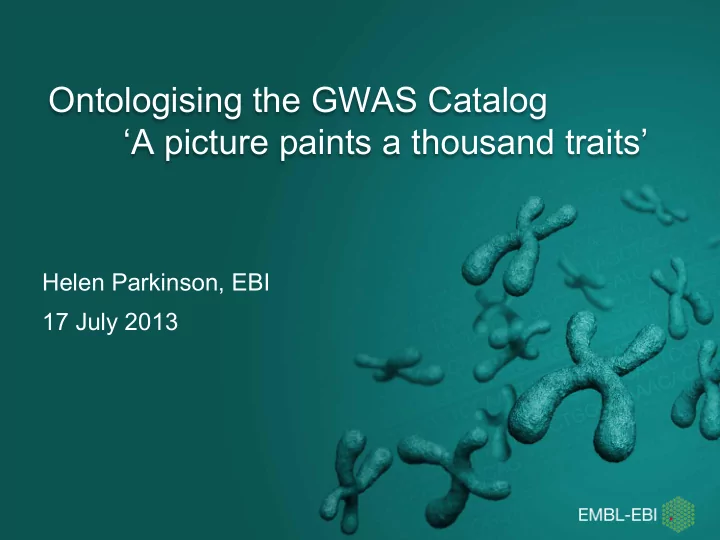

Ontologising the GWAS Catalog ‘A picture paints a thousand traits’ Helen Parkinson, EBI 17 July 2013
Overview • Introduction • Infrastructure and Ontology • GWAS diagram • Outlook July 26, 2013 2
The NHGRI GWAS catalog • Manual curation of published GWAS studies • Weekly literature search to identify new studies • Manual data extraction into web interface • Data entry double-checked by 2 nd -level curator • Quarterly release of GWAS diagrams • Process failing to scale release ¡ Dec 2012 ¡ papers ¡ 1724 ¡ #SNPs p<5E-8 ¡ 5035 ¡ #SNP-trait assocations p<5E-8 ¡ 12593 ¡ http://www.genome.gov/gwastudies
EBI/NHGRI collaboration • 2-year collaboration between the GWAS catalog team at the NHGRI and the Functional Genomics Productions (development) and Vertebrate Genomics (curation & display through Ensembl variation) teams at EBI • Aims Manual Automated visualisation visualisation Unstructured Structured data data Static Dynamic visual visual interface querying
Curation infrastructure • Development of tools to increase efficiency and accuracy of curation of data into the GWAS catalogue • Catalogue curation currently a labour intensive, entirely manual process • Development of an online tracking system to • Automatically perform Pubmed searches and enter papers into the system for review by curators • Triage papers • Assignment of papers to the appropriate curator for each stage of the curation process • Extract data from papers – SNP batchloader • Record progress Genomic Weekly literature Data Data double- Publication annotation search & eligibility extraction check to web (NCBI) AUTOMATE AUTOMATE
GWAS traits • GWAS catalogue traits previously only available as an unstructured list Long tail on the data • Traits are highly diverse, including • Phenotypes, e.g. hair colour • Treatment responses, e.g. response to antineoplastic agents • Diseases, e.g. type 2 diabetes • Assays – glcyoslyated haemoglogin level • Chemical/drug names, e.g. C-reactive protein • Traits are often compound and/or context-dependent e.g. “Type 2 diabetes and gout” or “Parkinson’s disease (interaction with caffeine)”
Ontology • Integration of traits into the structured hierarchy of an ontology, with additional semantically meaningful links between traits allows much more complex and extensive querying, e.g. “Show me all SNPs associated with type 2 diabetes and metabolic syndrome” • Two options for ontology integration Ø Create new “GWAS ontology” Ø Integrate with an existing ontology
Integration with “Experimental Factor Ontology” • EFO is actively developed • Well-suited to covering diversity of GWAS traits • 20% of GWAS traits already found in EFO prior to integration process • ~500 new terms added over 5 releases = 100% coverage GWAS data • Very high integration potential Pride, BioSamples etc
New and more powerful queries • Knowledge base that imports all the GWAS catalogue data and EFO GWAS knowledge base Other potential input sources Ø More powerful queries e.g. “Show me all SNPs associated with type 2 diabetes and metabolic syndrome, with a p-value of 10 -5 , from papers published before January 2010” Ø Facilitate visualisation Ø Increased integration potential, interoperability with other ontologies
GWAS diagram • Visualisation of all SNP-trait associations with p-value < 10 -8 • Generated quarterly by a graphic artist following extensive manual curation of the data • Static image in PDF or Powerpoint format • Too many traits and colours to reliably identify any individual feature • Great way of visualising the evolution of the catalogue over time
24 January 2012 11
24/01/12 12
GWAS diagram automation • Programmatic generation of the GWAS diagram from the GWAS/EFO knowledgebase • Interactive diagram that can filtered by a number of criteria, e.g. to show only traits associated with a given disease • Interactive traits (“dots”) that link directly into the catalogue • New colour scheme with fewer colours representing higher-level trait categories, e.g. mental health disorders, cancers, cardio-vascular diseases
GWAS Visualisation www.ebi.ac.uk/fgpt/ gwas wwwdev.ebi.ac.uk/fgpt/gwas/#
GWAS Data integration
Current status Automated Manual visualisation visualisation Unstructured Structured data data Static Dynamic visual visual interface querying • Web-application with back-end implemented in Java, running on an Apache Tomcat server • Diagram generated in SVG • Web-client – server communication via AJAX • Client-side diagram manipulation in Javascript • Hermit reasoner for classifying the OWL knowledgebase • Continuous integration - monthly code releases, supporting data releases • Code available on github, ontology available, all data available • Component based Integration with NHGRI’s Cold Fusion system for curation tracking
Summary • Restructured GWAS catalogue data to allow querying beyond direct string matching • Harmonised terms for all catalog content, re-mapped catalogue data for easier integration with other data sources • Modelled the traits explicitly – e.g. disease and measurement • Added new terms to the ontology to support the catalog • Removed manual processing from catalogue visualisation • Supported curators to choose terms during curation • Used semantic web technologies for querying and visualisation of catalogue data
Future work • Explore different resolution strategies for high-density regions • Capture, model and query ethnicity information • Better integration with genome browser • Per study queries • SNP level trait annotation and query • Connect disease, phenotype and assays • ‘give me everything you have about diabetes’
Acknowledgements • EBI • Tony Burdett • NHGRI • Jon Ison • Peggy Hall • Simon Jupp • Lucia Hindorff • James Malone • Heather Junkins • Helen Parkinson • Kent Klemm • Joanella Morales • Darryl Leja • Jackie MacArthur • Teri Manolio • Dani Welter NHGRI grant 3U41-HG006104-01S1 EMBL Core Funds
Recommend
More recommend